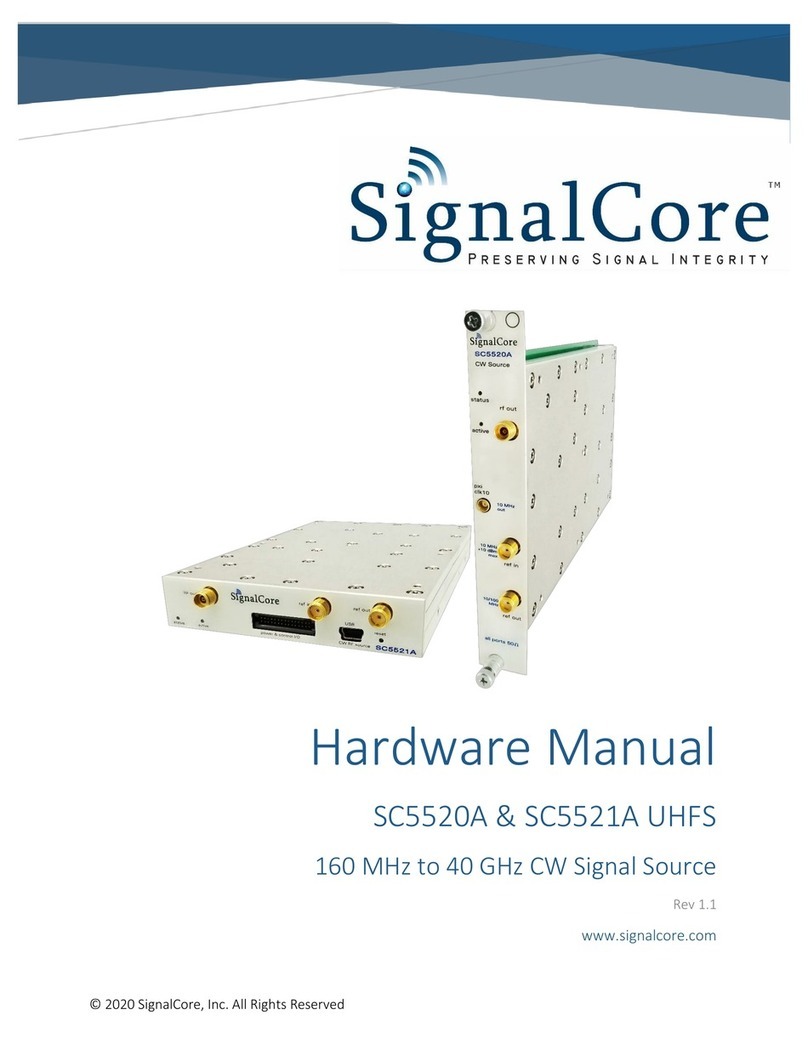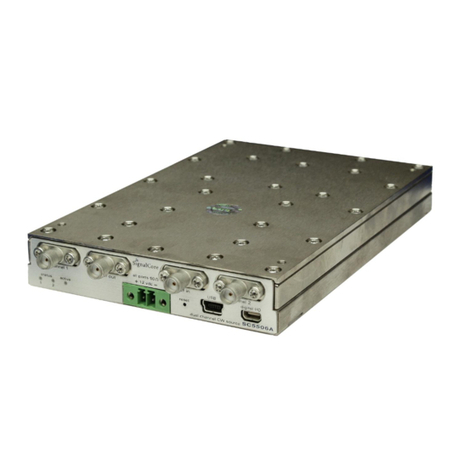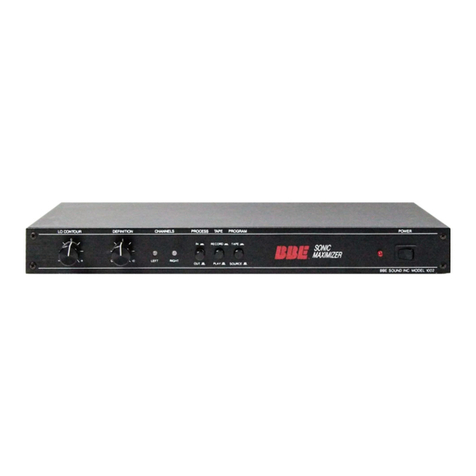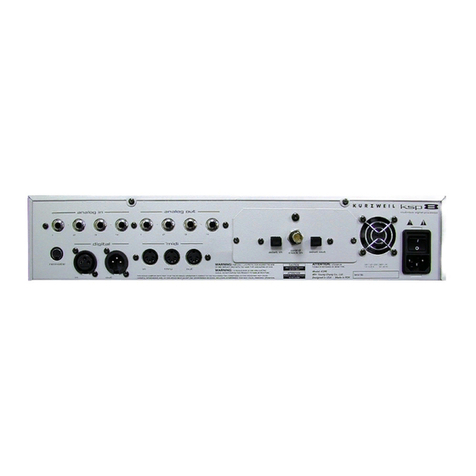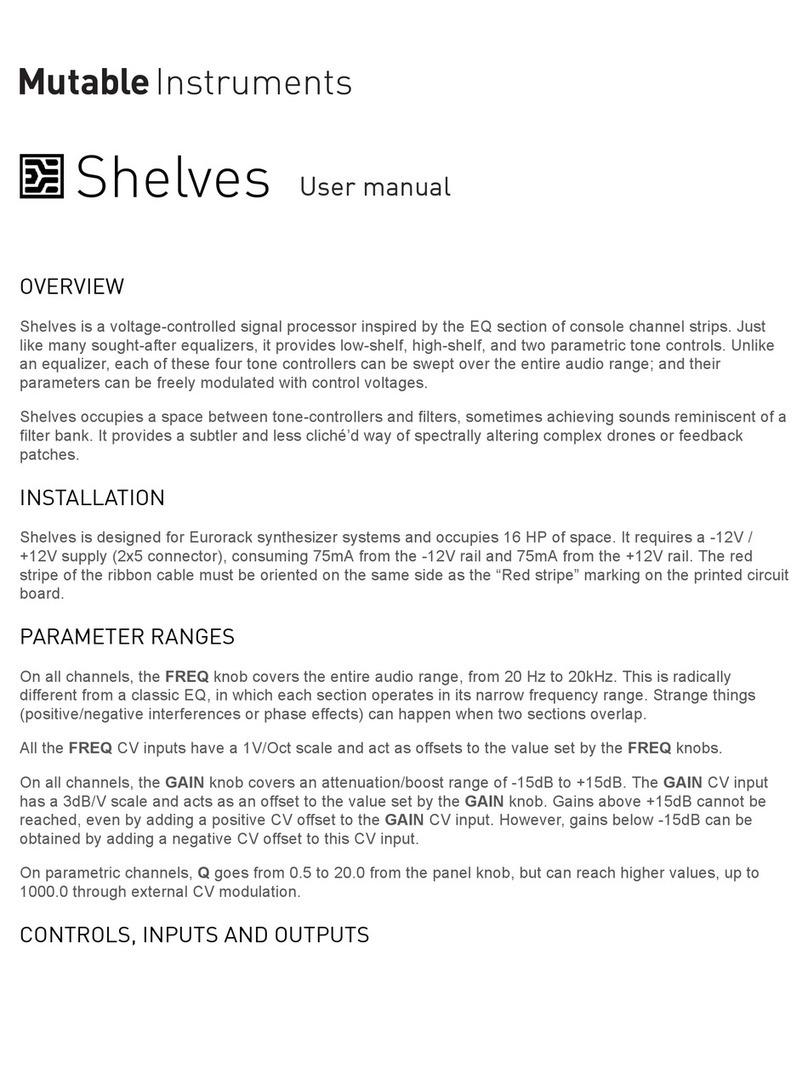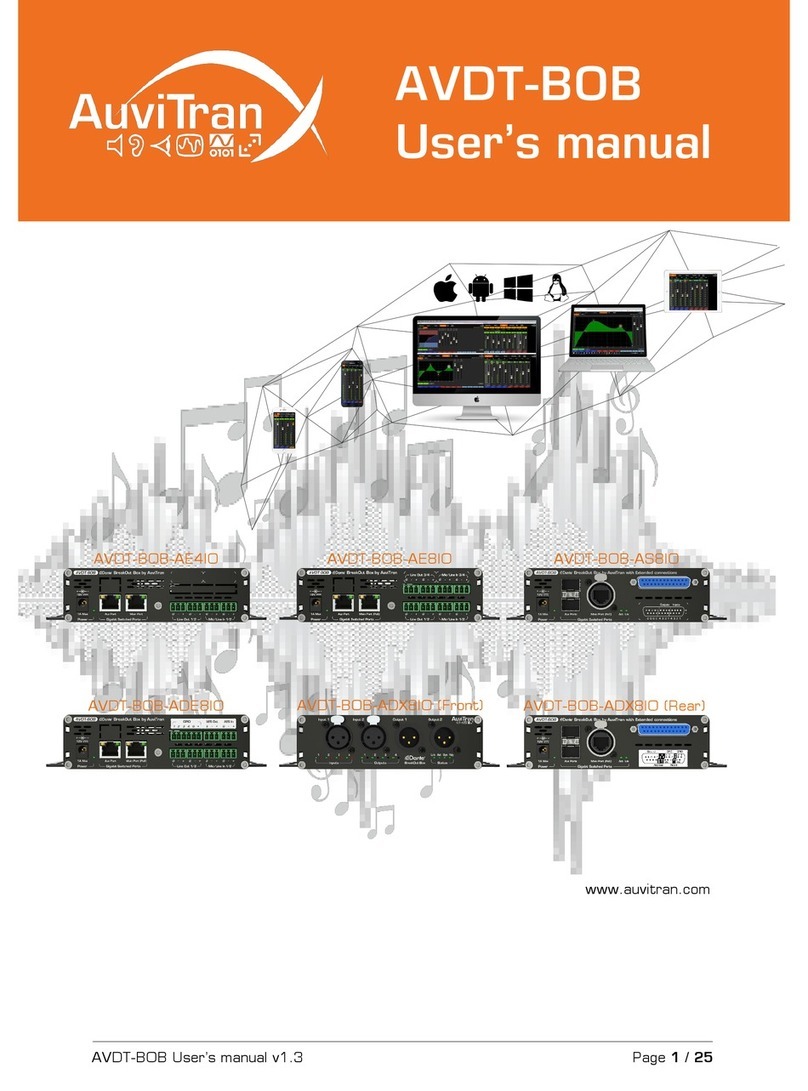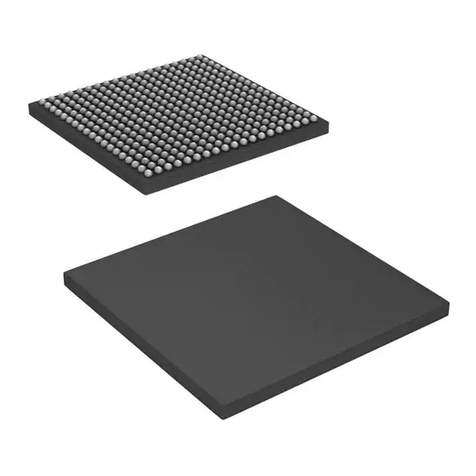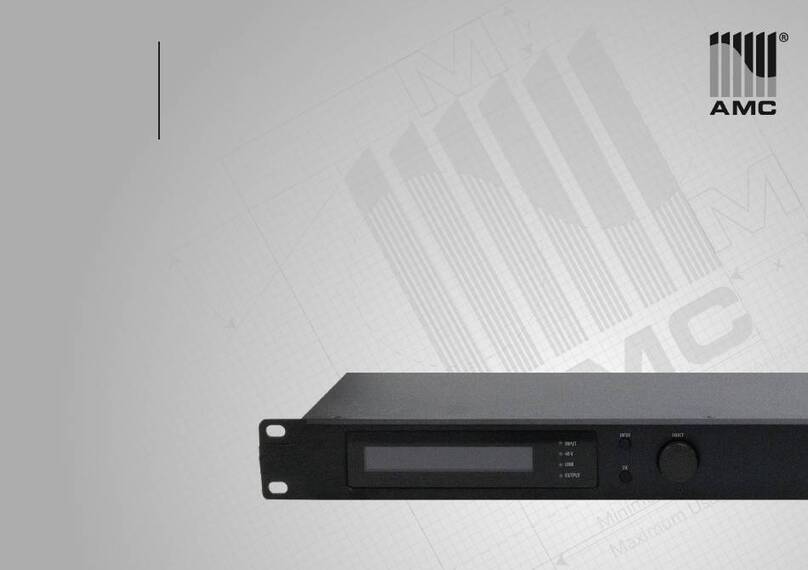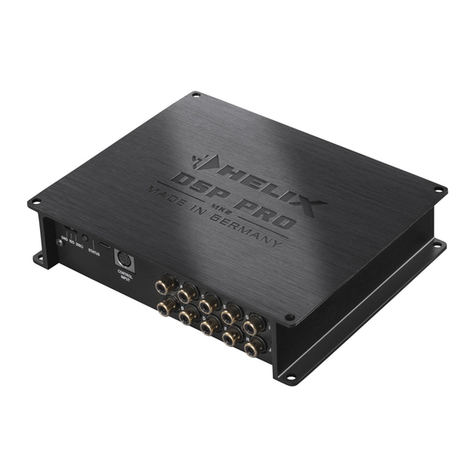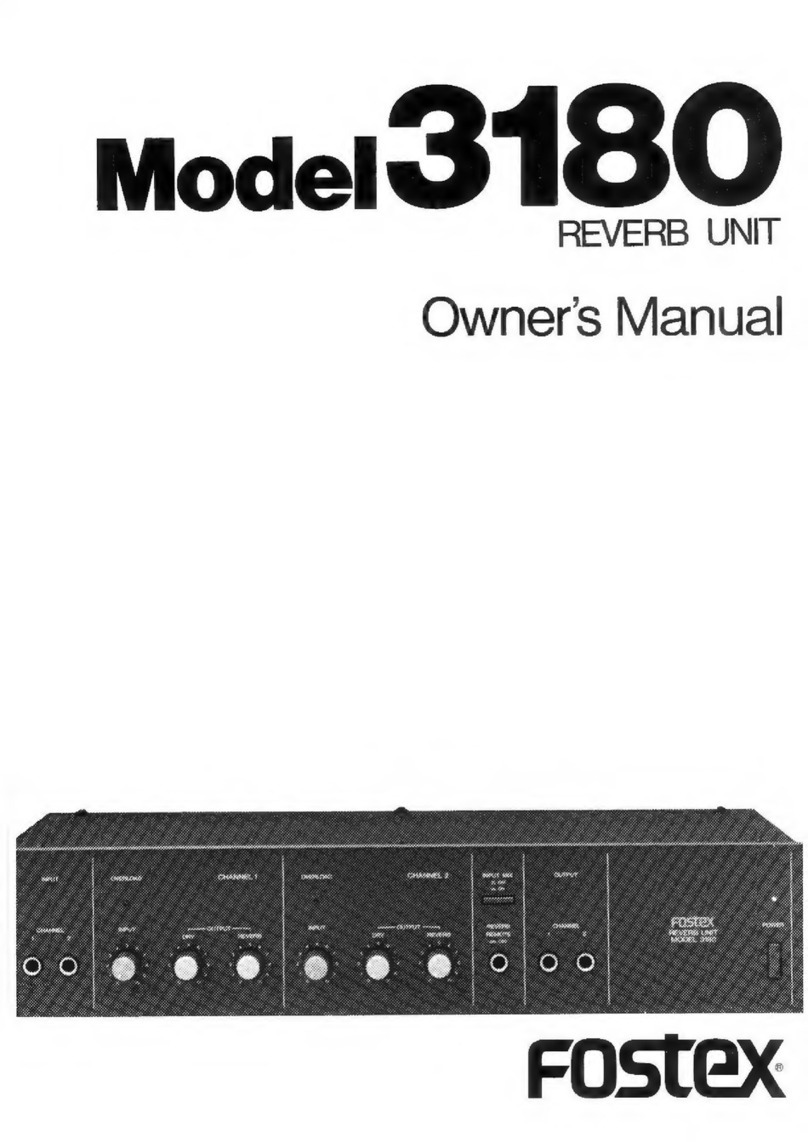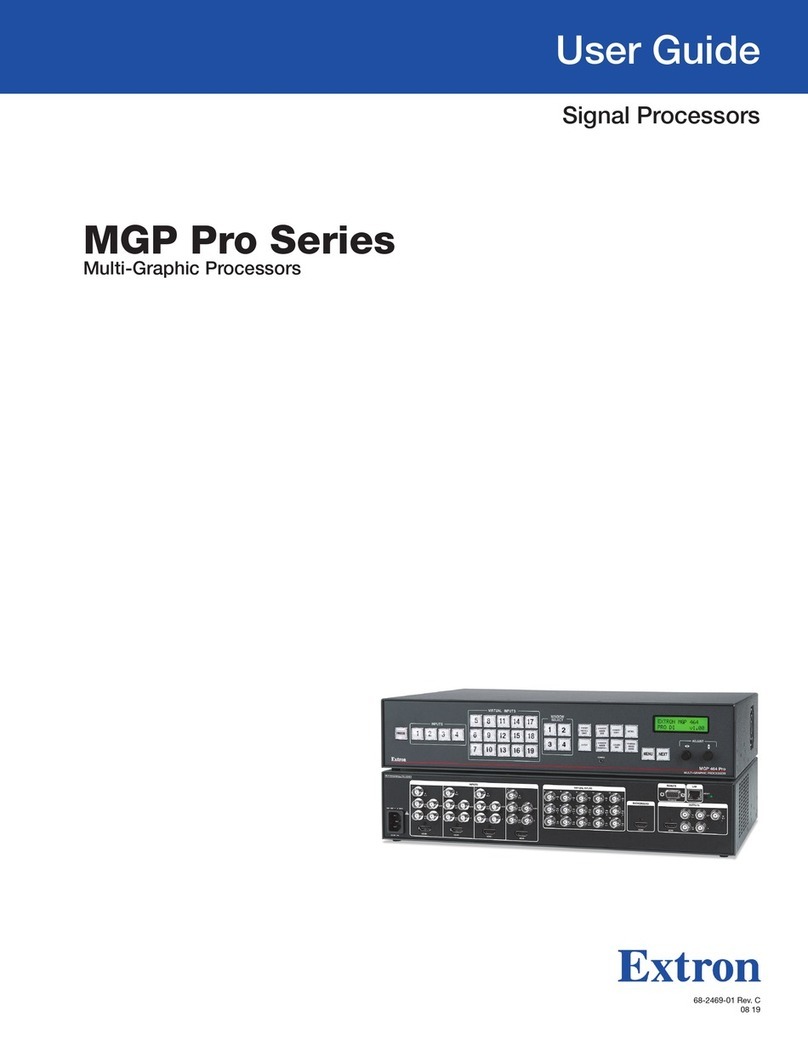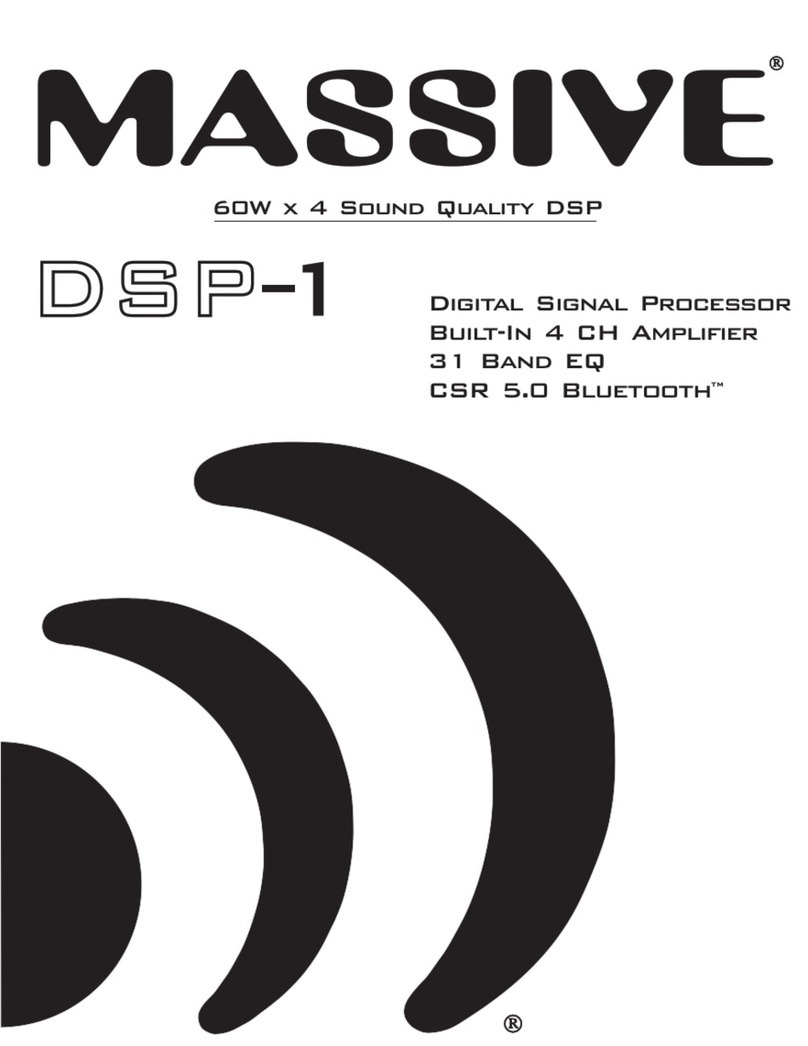SIGNALCORE SC5312A User manual

©2013 Rev 2.1
1
General Information
Table of Contents
1General Information..............................................................................................................................4
Warranty .......................................................................................................................................4
Copyright & Trademarks................................................................................................................4
International Materials Declarations.............................................................................................5
CE European Union EMC & Safety Compliance Declaration..........................................................5
Warnings Regarding Use of SignalCore Products ..........................................................................6
2Physical Description...............................................................................................................................7
Unpacking......................................................................................................................................7
Setting Up the Device....................................................................................................................7
Front Interface Indicators and Connectors....................................................................................8
Power Connection.................................................................................................................9
Signal Connections ................................................................................................................9
Baseband Connections ........................................................................................................10
Device LED Indicators ..........................................................................................................10
Mini-USB Connection ..........................................................................................................10
Reset Button (Pin Hole) .......................................................................................................11
3Functional Description.........................................................................................................................11
Overview .....................................................................................................................................11
The RF Input ........................................................................................................................11
IF Input Section....................................................................................................................13
IF Output Section.................................................................................................................14
4Hardware Registers .............................................................................................................................15
Configuration Registers ...............................................................................................................15
Register 0x02 SET_SYS_ACTIVE ...........................................................................................16
Register 0x03 SYNTH_MODE (2 Bytes) ................................................................................17
Register 0x10 RF_FREQUENCY ............................................................................................17
Register 0x11 IF_FREQUENCY..............................................................................................18
Register 0x14 RF_AMP ........................................................................................................18
Register 0x15 ATTENUATOR................................................................................................18
Register 0x16 SIGNAL_PATH................................................................................................19
Register 0x17 CONFIG_AUTO_GAIN....................................................................................20
Register 0x18 STORE_DEFAULT_STATE ...............................................................................21

Rev 2.1 | SC5312A & SC5313A User Manual SignalCore, Inc.
2
SC5312A & SC5313A Hardware Manual
Register 0x19 DEVICE_STANDBY .........................................................................................22
Register 0x1A REFERENCE_CLOCK.......................................................................................22
Register 0x1B REFERENCE_DAC...........................................................................................23
Register 0x1C LO1_PATH.....................................................................................................23
Register 0x1D SYNTH_SELF_CAL..........................................................................................23
Register 0x1E USER_EEPROM_WRITE .................................................................................24
Register 0x1F FREQ_PLAN_PARAM .....................................................................................24
Query Registers ...........................................................................................................................25
Register 0x30 GET_DEVICE_PARAM....................................................................................25
Register 0x31 GET_TEMPERATURE .....................................................................................26
Register 0x32 GET_DEVICE_STATUS....................................................................................26
Register 0x33 GET_DEVICE_INFO........................................................................................28
Register 0x34 CAL_EEPROM_READ .....................................................................................29
Register 0x35 USER_EEPROM_READ...................................................................................29
Register 0x36 SERIAL_OUT_BUFFER....................................................................................30
Device Parameters Data and Format...................................................................................30
Device Information Parameters and Format.......................................................................31
5Communication Interfaces ....................................................................................................................2
Communication Data Format ........................................................................................................2
USB Interface.................................................................................................................................2
Control Transfer ....................................................................................................................2
Bulk Transfer .........................................................................................................................2
SPI Interface ..................................................................................................................................3
Writing the SPI Bus................................................................................................................ 4
Reading the SPI Bus ...............................................................................................................4
RS232 Interface .............................................................................................................................5
Writing to the Device Via RS232............................................................................................5
Reading from the Device Via RS232 ......................................................................................6
PXI Express ....................................................................................................................................6
Setting Up the PCI to Serial Bridge ........................................................................................6
Writing to the Device.............................................................................................................7
Reading from the Device .......................................................................................................7
6Calibration.............................................................................................................................................8

©2013 Rev 2.1
3
General Information
Calibration EEPROM Map..............................................................................................................8
Absolute Conversion Gain .............................................................................................................9
Absolute Gain of the RF Conversion Path......................................................................................9
Gain Through the Bypass RF Conversion Path.............................................................................10
Applying Calibration ............................................................................................................10
Revision Table..............................................................................................................................................12

Rev 2.1 | SC5312A & SC5313A User Manual SignalCore, Inc.
4
SC5312A & SC5313A Hardware Manual
1General Information
Warranty
This product is warranted against defects in materials and workmanship for a period of three years from
the date of shipment. SignalCore will, at its option, repair or replace equipment that proves to be defective
during the warranty period. This warranty includes parts and labor.
Before any equipment will be accepted for warranty repair or replacement, a Return Material Authorization
(RMA) number must be obtained from a SignalCore customer service representative and clearly marked on
the outside of the return package. SignalCore will pay all shipping costs relating to warranty repair or
replacement.
SignalCore strives to make the information in this document as accurate as possible. The document has
been carefully reviewed for technical and typographic accuracy. If technical or typographical errors exist,
SignalCore reserves the right to make changes to subsequent editions of this document without prior notice
to possessors of this edition. Please contact SignalCore if errors are suspected. In no event shall SignalCore
be liable for any damages arising out of or related to this document or the information contained in it.
EXCEPT AS SPECIFIED HEREIN, SIGNALCORE, INCORPORATED MAKES NO WARRANTIES, EXPRESS OR
IMPLIED, AND SPECIFICALLY DISCLAIMS ANY WARRANTY OF MERCHANTABILITY OR FITNESS FOR A
PARTICULAR PURPOSE. CUSTOMER’S RIGHT TO RECOVER DAMAGES CAUSED BY FAULT OR NEGLIGENCE
ON THE PART OF SIGNALCORE, INCORPORATED SHALL BE LIMITED TO THE AMOUNT THERETOFORE PAID
BY THE CUSTOMER. SIGNALCORE, INCORPORATED WILL NOT BE LIABLE FOR DAMAGES RESULTING FROM
LOSS OF DATA, PROFITS, USE OF PRODUCTS, OR INCIDENTAL OR CONSEQUENTIAL DAMAGES, EVEN IF
ADVISED OF THE POSSIBILITY THEREOF. This limitation of the liability of SignalCore, Incorporated will apply
regardless of the form of action, whether in contract or tort, including negligence. Any action against
SignalCore, Incorporated must be brought within one year after the cause of action accrues. SignalCore,
Incorporated shall not be liable for any delay in performance due to causes beyond its reasonable control.
The warranty provided herein does not cover damages, defects, malfunctions, or service failures caused by
owner’s failure to follow SignalCore, Incorporated’s installation, operation, or maintenance instructions;
owner’s modification of the product; owner’s abuse, misuse, or negligent acts; and power failure or surges,
fire, flood, accident, actions of third parties, or other events outside reasonable control.
Copyright & Trademarks
Under the copyright laws, this publication may not be reproduced or transmitted in any form, electronic or
mechanical, including photocopying, recording, storing in an information retrieval system, or translating, in
whole or in part, without the prior written consent of SignalCore, Incorporated.
SignalCore, Incorporated respects the intellectual property rights of others, and we ask those who use our
products to do the same. Copyright and other intellectual property laws protect our products. Use of
SignalCore products is restricted to applications that do not infringe on the intellectual property rights of
others.

©2013 Rev 2.1
5
General Information
“SignalCore”, “signalcore.com”, and the phrase “preserving signal integrity” are registered trademarks of
SignalCore, Incorporated. Other product and company names mentioned herein are trademarks or trade
names of their respective companies.
International Materials Declarations
SignalCore, Incorporated uses a fully RoHS compliant manufacturing process for our products. Therefore,
SignalCore hereby declares that its products do not contain restricted materials as defined by European
Union directive 2002/95/EC (EU RoHS) in any amounts higher than limits stated in the directive. This
statement assumes reliable information and data provided by our component suppliers and may not have
been independently verified through other means. For products sold into China, we also comply with the
“Administrative Measure on the Control of Pollution Caused by Electronic Information Products” (China
RoHS). In the current stage of this legislation, the content of six hazardous materials must be explicitly
declared. Each of those materials, and the categorical amount present in our products, are shown below:
鉛
Lead
(Pb)
汞
Mercury
(Hg)
镉
Cadmium
(Cd)
六价铬
Hexavalent
Chromium
(Cr(VI))
多溴联苯
Polybrominated
biphenyls
(PBB)
多溴二苯醚
Polybrominated
diphenyl ethers
(PBDE)
✓
✓
✓
✓
✓
✓
A ✓indicates that the hazardous substance contained in all of the homogeneous materials for this product
is below the limit requirement in SJ/T11363-2006. An Xindicates that the particular hazardous substance
contained in at least one of the homogeneous materials used for this product is above the limit requirement
in SJ/T11363-2006.
CE European Union EMC & Safety Compliance Declaration
The European Conformity (CE) marking is affixed to products with input of 50 - 1,000 Vac or 75 - 1,500 Vdc
and/or for products which may cause or be affected by electromagnetic disturbance. The CE marking
symbolizes conformity of the product with the applicable requirements. CE compliance is a manufacturer’s
self-declaration allowing products to circulate freely within the European Union (EU). SignalCore products
meet the essential requirements of Directives 2004/108/EC (EMC) and 2006/95/EC (product safety) and
comply with the relevant standards. Standards for Measurement, Control and Laboratory Equipment
include EN 61326 and EN 55011 for EMC, and EN 61010-1 for product safety.

Rev 2.1 | SC5312A & SC5313A User Manual SignalCore, Inc.
6
SC5312A & SC5313A Hardware Manual
Warnings Regarding Use of SignalCore Products
(1)
PRODUCTS FOR SALE BY SIGNALCORE, INCORPORATED ARE NOT DESIGNED WITH COMPONENTS NOR TESTED
FOR A LEVEL OF RELIABILITY SUITABLE FOR USE IN OR IN CONNECTION WITH SURGICAL IMPLANTS OR AS
CRITICAL COMPONENTS IN ANY LIFE SUPPORT SYSTEMS WHOSE FAILURE TO PERFORM CAN REASONABLY BE
EXPECTED TO CAUSE SIGNIFICANT INJURY TO A HUMAN.
(2)
IN ANY APPLICATION, INCLUDING THE ABOVE, RELIABILITY OF OPERATION OF THE SOFTWARE PRODUCTS CAN
BE IMPAIRED BY ADVERSE FACTORS, INCLUDING BUT NOT LIMITED TO FLUCTUATIONS IN ELECTRICAL POWER
SUPPLY, COMPUTER HARDWARE MALFUNCTIONS, COMPUTER OPERATING SYSTEM SOFTWARE FITNESS,
FITNESS OF COMPILERS AND DEVELOPMENT SOFTWARE USED TO DEVELOP AN APPLICATION, INSTALLATION
ERRORS, SOFTWARE AND HARDWARE COMPATIBILITY PROBLEMS, MALFUNCTIONS OR FAILURES OF
ELECTRONIC MONITORING OR CONTROL DEVICES, TRANSIENT FAILURES OF ELECTRONIC SYSTEMS
(HARDWARE AND/OR SOFTWARE), UNANTICIPATED USES OR MISUSES, OR ERRORS ON THE PART OF THE USER
OR APPLICATIONS DESIGNER (ADVERSE FACTORS SUCH AS THESE ARE HEREAFTER COLLECTIVELY TERMED
“SYSTEM FAILURES”). ANY APPLICATION WHERE A SYSTEM FAILURE WOULD CREATE A RISK OF HARM TO
PROPERTY OR PERSONS (INCLUDING THE RISK OF BODILY INJURY AND DEATH) SHOULD NOT BE SOLELY
RELIANT UPON ANY ONE COMPONENT DUE TO THE RISK OF SYSTEM FAILURE. TO AVOID DAMAGE, INJURY,
OR DEATH, THE USER OR APPLICATION DESIGNER MUST TAKE REASONABLY PRUDENT STEPS TO PROTECT
AGAINST SYSTEM FAILURES, INCLUDING BUT NOT LIMITED TO BACK-UP OR SHUT DOWN MECHANISMS.
BECAUSE EACH END-USER SYSTEM IS CUSTOMIZED AND DIFFERS FROM SIGNALCORE'S TESTING PLATFORMS,
AND BECAUSE A USER OR APPLICATION DESIGNER MAY USE SIGNALCORE PRODUCTS IN COMBINATION WITH
OTHER PRODUCTS IN A MANNER NOT EVALUATED OR CONTEMPLATED BY SIGNALCORE, THE USER OR
APPLICATION DESIGNER IS ULTIMATELY RESPONSIBLE FOR VERIFYING AND VALIDATING THE SUITABILITY OF
SIGNALCORE PRODUCTS WHENEVER SIGNALCORE PRODUCTS ARE INCORPORATED IN A SYSTEM OR
APPLICATION, INCLUDING, WITHOUT LIMITATION, THE APPROPRIATE DESIGN, PROCESS AND SAFETY LEVEL
OF SUCH SYSTEM OR APPLICATION.

©2013 Rev 2.1
7
Physical Description
2Physical Description
Unpacking
All SignalCore products ship in antistatic packaging (bags) to prevent damage from electrostatic discharge
(ESD). Under certain conditions, an ESD event can instantly and permanently damage several of the
components found in SignalCore products. Therefore, to avoid damage when handling any SignalCore
hardware, you must take the following precautions:
1. Ground yourself using a grounding strap or by touching a grounded metal object.
2. Touch the antistatic bag to a grounded metal object before removing the hardware from
its packaging.
3. NEVER touch exposed signal pins. Due to the inherent performance degradation caused
by ESD protection circuits in the RF path, the device has minimal ESD protection against
direct injection of ESD into the RF signal pins.
4. When not in use, store all SignalCore products in their original antistatic bags.
Remove the product from its packaging and inspect it for loose components or any signs of damage. Notify
SignalCore immediately if the product appears damaged in any way.
Setting Up the Device
Integration of the SC5312A and SC5313A modules requires attention to maintain effective cooling.
Inadequate cooling can cause the temperature inside the RF housing to rise above the maximum for this
product, leading to improper performance, reduction of product lifespan or complete product failure.
SignalCore suggests providing either moderate airflow across the RF housing, or if active cooling is not an
option, using thermal interface materials to bond the RF housing to a larger heatsinking surface (i.e. a
system enclosure). As each system configuration into which the device is integrated is unique, detailed
cooling options cannot be provided.
A cooling plan is sufficient when the SC5312A and SC5313A on-board temperature sensors indicate a rise
of no more than 20°C above ambient temperature under normal operating conditions.

Rev 2.1 | SC5312A & SC5313A User Manual SignalCore, Inc.
8
SC5312A & SC5313A Hardware Manual
Front Interface Indicators and Connectors
The SC5312A is a PXIe-based RF downconverter with all user I/O located on the front face of the module
as shown below.

©2013 Rev 2.1
9
Physical Description
The SC5313A is a core module-based IQ demodulator with all I/O connections and indicators located on
the front face of the module as shown below.
Power Connection
Power to the SC5313A is provided to the device through a two-position screw terminal block connection.
Proper operation of the device requires a +12 VDC source and ground return wires capable of delivering a
minimum current of 1.5 amps. The polarity of the connector is shown on the front panel of the RF
module, just above the screw terminal block.
Signal Connections
All signal connections (ports) on the device are SMA-type. Exercise caution when fastening cables to the
signal connections. Over-tightening any connection can cause permanent damage to the device.
The condition of your system signal connections can significantly affect measurement accuracy and
repeatability. Improperly mated connections or dirty, damaged, or worn connectors can degrade
measurement performance. Clean out any loose, dry debris from connectors with clean, low-
pressure air (available in spray cans from office supply stores).
If deeper cleaning is necessary, use lint-free swabs and isopropyl alcohol to gently clean inside the
connector barrel and the external threads. Do not mate connectors until the alcohol has completely
evaporated. Excess liquid alcohol trapped inside the connector may take several days to fully
evaporate and may degrade measurement performance until fully evaporated.
Tighten all SMA connections with 3 in-lb min to 5 in-lb max (56 N-cm max)
LO Out
This port outputs the tunable LO signal allowing phase-
coherent daisy-chaining of multiple IQ demodulator modules.
The connector is SMA female. The nominal output impedance
is 50 .
RF In
This port accepts an RF signal ranging from 400 MHz to 6 GHz.
The connector is SMA female. The nominal input impedance is
50 . Maximum input power is +23 dBm with ATTEN#1 set to
at least 10 dB attenuation.

Rev 2.1 | SC5312A & SC5313A User Manual SignalCore, Inc.
10
SC5312A & SC5313A Hardware Manual
RF Aux In
This port accepts an RF signal ranging from 400 MHz to 6 GHz.
This port can be used as an alternate path for system-level
calibration. The connector is SMA female. The nominal input
impedance is 50 .
LO In
This port accepts a tunable LO signal from an external source
to drive the demodulator. The connector is SMA female. This
port is AC-coupled with a nominal input impedance of 50 .
Maximum input power is +10 dBm.
Baseband Connections
The SC5312A and SC5313A have four baseband output ports comprised of differential in-phase (I+ and I-)
and differential quadrature (Q+ and Q-) outputs. Nominal differential output impedance is 100 The
demodulator can also be configured for single-ended or differential IF output. When configured for
single-ended operation, it is recommended to terminate the other half of the differential pair using a 50
terminator. All baseband connectors are MCX female.
Device LED Indicators
These are two LED indicator lights for the device, and their functions are listed in Table 1 and
Table 2.
Table 1. Status LED Indicator (SC5312A ONLY)
LED Color
Description
Green
The device is functioning properly in the state that it is programmed for.
Off
No supply or supply error.
Table 2. Active LED Indicator (this indicator is user programmable)
LED Color
Description
Green
Device is open. (Communication has been established)
Orange*
Device is powered on and working properly
Off
Device is closed.
*SC5313A ONLY
Mini-USB Connection
The SC5313A uses a mini-USB Type B connector for primary communication with the device using the
standard USB 2.0 protocol (full speed) found on most host computers. The pinout of this connector,
viewed from the front, is shown in the following table.

©2013 Rev 2.1
11
Functional Description
PIN #
USB Function
Description
1
VBUS
Vcc (+5 Volts)
2
D-
Serial Data (neg)
3
D+
Serial Data (pos)
4
ID
Not Used
5
GND
Device Ground (also tied to connector shell)
Reset Button (Pin Hole)
Behind this pin hole is the reset button, which is only available on the SC5308A. Using a pin to lightly
depress this momentary-action push button switch will cause a hard reset to the device, putting it back to
its default settings. All user settings will be lost. System reset capability can also be accessed through the
communication header connector.
3Functional Description
Overview
The SC5312A uses USB as its primary interface with an optional SPI or RS232 interface. The SC5313A is a
PXIe version of the product. They are single-stage, direct conversion Inphase-Quadrature (IQ)
demodulating mixers. They can operate as a single-stage downconverter or as an IQ demodulator. These
modules operate in the 400 MHz to 6 GHz RF range with a typical 3 dB IF bandwidth of 160 MHz in single-
stage converter mode and 320 MHz in IQ mode. The RF input stage has adjustable gain to allow
adjustment of the incoming RF signal prior to the demodulation process for the purpose of optimizing RF
dynamic range. The IF stage has adjustable gain to ensure that linearity and noise of the IF output are
optimized. The modules have the necessary RF amplifiers, attenuators, IF amplifiers, and IF control via
DACs to allow the user to optimally operate the device over the entire frequency range as well as for both
small and large RF input levels. The following sections provide in depth information on how to optimize
the modules for linearity and signal-to-noise dynamic range.
The RF Input
In the design of the RF input section, care was taken to ensure that the dynamic range of the IQ
demodulator is preserved as seen at the input port of the device. This requires that the demodulator is not
driven too hard (high signal amplitude) or too soft (low signal amplitude). When the device is driven hard,
nonlinear effects dominate the system. When driven too softly, signal-to-noise dynamic range suffers. A
general rule is to apply more attenuation earlier in the RF signal path to improve linearity, and more gain
to improve signal-to-noise performance. As an example, for a given input signal level and while maintaining
a relatively constant output IF level, the user would switch in RF AMP#1 and apply attenuation on ATTEN#3
to improve signal-to-noise dynamic range. The factory default state sets all the RF amplifiers off, all
attenuators set to 0 dB attenuation, and the IF gain set to 8 dB (DAC code of 32). In this default state, the
device is optimized for a -10 dBm RF signal in the 1.0 GHz to 2.4 GHz range. The IF output is typically 0.5 V
- 1.0 V peak-to-peak differential at these settings.

Rev 2.1 | SC5312A & SC5313A User Manual SignalCore, Inc.
12
SC5312A & SC5313A Hardware Manual
The RF amplifiers are used to improve the gain of the device if the input signal is too low or when the losses
at higher frequencies are large. RF AMP#1 is usually selected when the RF signals are lower than -25 dBm
at the input port. With RF AMP#1 enabled, the device sensitivity is improved and the detection of low level
signals is better resolved. RF AMP#2 should be selected and switched into the signal path at RF frequencies
greater than 5 GHz, where the signal power loss through the front end prior to the demodulator can be as
high as 15 dB due to filter and switch insertion losses. At these high RF frequencies, if the IF gain is at its
maximum of 15.75 dB (DAC code = 63) and the IF output level falls below -10 dBm or outside the digitizer’s
optimal levels, RF AMP#2 should be enabled.
Figure 1. Block diagram of the signal conversion module of the downconverter assembly
The RF attenuators provide attenuation when required. RF ATTEN#1 attenuation should be stepped up as
the signal power at the RF port increases above -10 dBm. Nonlinear components of the signal such as IMD3
and second order harmonics will increase in magnitude as the input signal increases; therefore the user
should exercise good judgment to determine when to use RF ATTEN#1. Do not over-attenuate. Doing so
will negatively impact the signal-to-noise ratio.
RF ATTEN#2 is used when the input signal needs further suppression to improve linearity. It should also be
used if RF AMP#1 is enabled to improve sensitivity, but as a result the level at the input of RF AMP#3 (always
in the path) may be too high. Step up the attenuation of RF ATTEN#2 to ensure the system (resulting from
RF AMP#3) is not driven too hard. Finally RF ATTEN#3 is used to control the level to the IQ demodulator
when RF AMP#2 is enabled (switched into the signal path).
Vocm
Dac
DC
Offset
DAC
2.5V
Ref
i+
i-
5V
Ref
Vocm
Variable
Diff Amp
Vocm Vocm
Out Diff
Amp
IQ
Demodulator
Linearity
Dac
90
0
i+
i-
50
50
RF Amp
#1 RF Amp
#3 RF Amp
#2
9 Selectable
RF Filters
9 Selectable
LO Filters
LO Amp
#2
LO Amp
#1
Gain
Selectable
IF Diff_Amp
RF Atten
#1 RF Atten
#2 RF Atten
#3

©2013 Rev 2.1
13
Functional Description
There is an auxiliary RF input to the device. This input is almost identical to the main RF input with the
exception of having an extra switch path. The intended use of this port is to allow the user a calibration
path without having to detach the device under test (DUT) already cabled to the main RF input port. The
user must perform in-situ equalization to remove IQ errors such as phase imbalance and quadrature gain
offsets that are inherent to the device. Providing this auxiliary path makes the task of characterizing the
system with and without a DUT much easier.
There are nine low pass filters in the RF filter bank. These filters are automatically selected when the user
enters the operating frequency. These filters can also be selected manually should the user choose to do
so. As with all filters there is generally an amplitude roll-off as the frequency nears its 3 dB cutoff point so
it is important to understand that frequencies near to the cutoff point may experience a slightly faster
roll-off of its IF bandwidth. A typical 1 dB IF bandwidth (IQ) is about 160 MHz. The user may want to
choose a higher frequency filter if this becomes a problem. See the programming section in this manual
for more details. The filters in both the RF and LO filter banks are identical and are listed below.
Filter
Number
1 dB Cutoff Frequency
0
400 MHz
1
500 MHz
2
650 MHz
3
1000 MHz
4
1400 MHz
5
2000 MHz
6
2825 MHz
7
3800 MHz
8
6000 MHz
IF Input Section
The SC5312A and SC5313A require an external RF signal as their “Local Oscillator” (LO) for the frequency
conversion process. The external RF signal must be connected to the “LO in” port. The typical required
input level is -3 dBm to 3 dBm. These levels are required to sufficiently drive the IQ demodulator for good
linearity performance and conversion loss. The LO signal is conditioned through a bank of low-pass filters
to reduce the signal harmonics. Reducing the harmonics produces a “purer” signal tone, improving the
duty cycle of the LO as it drives the mixers of the demodulator. Additionally, the LO signal can be passes
out of the device via the “LO out” port. This output can be used as the input LO source for another
demodulator, for example. Driving multiple demodulators with the same derived LO signal optimizes
phase coherency between them. When this port is not in use, it is highly recommended to terminate it
into a 50 load.

Rev 2.1 | SC5312A & SC5313A User Manual SignalCore, Inc.
14
SC5312A & SC5313A Hardware Manual
IF Output Section
The IF outputs are differentially driven. Each of the in-phase and quadrature components of the
demodulator are conditioned prior to leaving the IF ports. The user can programmatically adjust the
parameters of the differential signal such as the common output voltage, DC offset between the (-) and (+)
terminals, and its amplitude. The differential output impedance of each component is 100 and DC
coupled. However, all ports can be operated as AC coupled single-ended 50 ports. All unused ports
should be terminated into AC coupled 50 loads.
There are voltage DACs within the device to control the signal parameters of each of the IQ components.
For each component, the Vcom (common voltage) DAC controls the common output voltage of the
differential outputs. The Vcom DAC values range from 0 to 16383 (14 bits) and change the voltage between
1 - 3.5 V. For a wider output voltage swing range, this voltage should be set to about 2.4 - 2.5 V. Having a
wider swing range improves the output compression point of the device. This is not a hard requirement
and the user will need to adjust the voltage levels to suit their specific requirements. As an example, setting
to some other voltage may be required to optimize the dynamic range of the receiving digitizer and as a
result better optimize the entire system.
DC offsets may limit the dynamic range of the receiving digitizer and where it is critical the user can “tune
out” to minimize these offsets using the DC Offset DAC. This 14 bit DAC can correct offsets up to +/-0.050
V with less than 0.010 mV resolution.
The IF amplifiers have adjustable gain ranges from 0 to 15.75 dB, with a tuning resolution of 0.25 dB. The
gain is controlled by programming a 6-bit DAC whose codes range from 0 to 63. Writing 63 to the DAC
provides the highest gain. Increasing the IF gain instead of the RF gain to achieve a required IF level will
improve the linearity of the system but with the chance of a slight increase in output noise. For a common
output voltage of 2.4 V, the output compression/saturation point of the amplifier is around 10 dBm. It is
recommended to operate the output at least 6 dBm below this value to avoid running into saturation from
signals with high crest factors. When deciding the operating point of the digitizer, it is recommended that
the user not operate the output voltage too close to the saturation point of the digitizer input.
The linearity DAC controls the current flow throw the demodulator core and thus affects the linearity of
the device. Generally, increasing the voltage results in higher current consumption, and as a result the
linearity improves. However slight adjustments to the voltage may improve the linearity further; this is
dependent on the frequency and input power.

©2013 Rev 2.1
15
Hardware Registers
4Hardware Registers
The set of hardware registers of the downconverter may be divided into a configuration set and a query
set; the configuration registers are write-only registers to set up the states of the device, while the query
registers request the device to prepare and send back data associated with them. The registers are
identical for all communication interfaces: PXIe, USB, RS232, and SPI. Data communication to all
interfaces are sent in 1 byte wide, that is, data is transferred byte-by-byte. Register data lengths vary in
size, and it is important that the correct number of bytes are sent for the corresponding register. Failure
to do so may cause communication to lock-up and the device to become unresponsive.
Configuration Registers
These are write-only registers to configure the device. The registers vary in length to reduce redundant
data and improve the communication speed, especially for SPI and RS232 interfaces. Furthermore, it is
vitally important that the length of data written to a register is exact because failure to do so will cause
the interfaces to misinterpret the incoming data, leaving the device in a stalled state. The total number of
bytes is the sum of the register address (1 Byte) and its corresponding data bytes. For example, to set the
RF frequency value, eight bytes must be written; the sum of the 1 register byte and 7 data bytes. See the
RF_FREQUENCY register of Table 3. The table provides a summary of the configuration registers, and each
register is explained in detail.
Table 3. Configuration Registers
Register Name
Reg Add
Serial
Range
Bit 7
Bit 6
Bit 5
Bit 4
Bit 3
Bit 2
Bit 1
Bit 0
INITIALIZE
0x01
[7:0]
Set to zeros [7:1]
Mode
SYSTEM_ACTIVE
0x02
[7:0]
Set to zeros [7:1]
Enable
“active”
LED
SYNTH_MODE
0x03
[7:0]
Set to zeros [7:2]
Fast-
tune
Loop Gain
RF_FREQUENCY
0x10
[7:0]
Frequency Word (Hz) [7:0]
[15:8]
Frequency Word (Hz) [15:8]
[23:16]
Frequency Word (Hz) [23:16]
[31:24]
Frequency Word (Hz) [31:24]
[39:32]
Frequency Word (Hz) [39:32]
[47:40]
Frequency Word (Hz) [47:40]
[55:48]
Set to zeros
LO
IF_FREQUENCY
0x11
[7:0]
Frequency Word (Hz) [7:0]
[15:8]
Frequency Word (Hz) [15:8]
[23:16]
Frequency Word (Hz) [23:16]
[31:24]
Frequency Word (Hz) [31:24]
[39:32]
Frequency Word (Hz) [39:32]
[47:40]
Frequency Word (Hz) [47:40]
[55:48]
Set to zeros
RF_AMP
0x14
[7:0]
Set to zeros [7:1]
Enable
ATTENUATOR
0x15
[7:0]
0
Attenuator value
[15:8]
Set to zeros [15:11]
Attenuator Number
[23:16]
Set to zeros [23:16]
SIGNAL_PATH
0x16
[7:0]
If3
fil#2
select
If3 fil#1 select
IF2
filter
select
0
Bypass
IF3
conv
Ext. IF2
select
Bypass
convert
[15:8]
Set to zeros [15:10]
Rf amp
invert

Rev 2.1 | SC5312A & SC5313A User Manual SignalCore, Inc.
16
SC5312A & SC5313A Hardware Manual
Register Name
Reg Add
Serial
Range
Bit 7
Bit 6
Bit 5
Bit 4
Bit 3
Bit 2
Bit 1
Bit 0
[23:16]
Set to zeros [23:16]
CONFIG_AUTO_GAIN
0x17
[7:0]
Set to zeros [7:5]
Linear mode
Auto
ctrl
amp
Load
params
Auto
Enable
[15:8]
Sign
Absolute RF level (0 - 127) dB [6:0]
[23:16]
Sign
Absolute mixer level (0 - 127) dB [6:0]
[31:24]
Sign
Absolute IF level (0 - 127) dB [6:0]
[39:32]
Set to zeros
STORE_DEFAULT_STATE
0x18
[7:0]
Set all to zeros
DEVICE_STANDBY
0x19
[7:0]
Set to zeros [7:4]
Device sections
Enable
REFERENCE_CLOCK
0x1A
[7:0]
[7:4] set to zeros
PXI 10
enable
Clk 100
enable
Ref out
enable
Lock ext
REFERENCE_DAC
0x1B
[7:0]
DAC WORD [7:0]
[15:8]
0
0
DAC WORD [13:8]
[23:16]
Set to zeros
LO1_PATH
0x1C
[7:0]
0
0
0
0
0
0
0
Ext/Int
SYNTH_SELF_CAL
0x1D
[7:0]
Set all to zeros
USER_EEPROM_WRITE
0x1E
[7:0]
BYTE DATA [7:0]
[15:8]
ADDRESS [7:0]
[23:16]
ADDRESS [15:8]
FREQ_PLAN_PARAM
0x1F
[7:0]
Frequency word (Hz) [7:0]
[15:8]
Frequency word (Hz) [15:8]
[23:16]
Frequency word (Hz) [23:16]
[31:24]
Frequency word (Hz) [31:24]
[39:32]
Frequency word (Hz) [39:32]
[47:40]
Frequency word (Hz) [47:40]
[55:48]
Set to zeros [55:52]
PARAM [3:0]
Register 0x02 SET_SYS_ACTIVE
This register turns on or off the active LED indicator on the front connector interface of the device. This
register should be called when the device is opened or closed in software.
Bytes written
2
Bytes read
1
Bits
Type
Name
Width
Description
[0]
WO
Mode
1
0 = Turns off the active LED
1 = Turns on the active LED
[7:1]
WO
Unused
7
Set to zeros
[7:0]
RO
Read back byte
8
Read 1 byte back is required for PXIe and RS232

©2013 Rev 2.1
17
Hardware Registers
Register 0x03 SYNTH_MODE (2 Bytes)
This register configures the PLL loop gain of the local oscillator synthesizers. It also enables or disables
faster tuning of the YIG based oscillator of LO1.
Bytes written
2
Bytes read
1
Bits
Type
Name
Width
Description
[1:0]
WO
Loop Gain
2
0 = Low loop gain, improves phase noise > 50 kHz
1 = Normal loop gain
2 = High loop gain, improves phase noise < 50 kHz
[2]
WO
Fast Tune
1
0 = Turns fast tune off, default
1 = Turns fast tune on, close in phase noise may
degrade
[7:3]
WO
Unused
5
Set to zeros
[7:0]
RO
Read back byte
8
Read 1 byte back is required for PXIe and RS232
Register 0x10 RF_FREQUENCY
This register tunes the device to the input RF frequency.
Bytes written
8
Bytes read
1
Bits
Type
Name
Width
Description
[47:0]
W
Frequency word
48
Frequency word in milli-Hz (mHz); mHz used for
future compatibility
[48]
LO
1
Set to 1 to apply value directly to the first LO. The
RF frequency value is unchanged.
[55:49]
W
Unused
7
Set to zeros
[7:0]
RO
Read back byte
8
Read 1 byte back is required for PXIe and RS232

Rev 2.1 | SC5312A & SC5313A User Manual SignalCore, Inc.
18
SC5312A & SC5313A Hardware Manual
Register 0x11 IF_FREQUENCY
This register sets the final IF value.
Bytes written
2
Bytes read
1
Bits
Type
Name
Width
Description
[47:0]
W
Frequency word
48
Frequency word in milli-Hz (mHz); mHz used for
future compatibility
[55:48]
W
Used
8
Set to zeros
[7:0]
R
Read back byte
8
Read 1 byte back is required for PXIe and RS232
Register 0x14 RF_AMP
This register enables and disables the RF amplifier.
Bytes written
2
Bytes read
1
Bits
Type
Name
Width
Description
[0]
W
Frequency word
1
0 = Disables the RF amplifier
1 = Enables the RF amplifier
[7:1]
W
Unused
7
Set to zeros
[7:0]
R
Read back byte
8
Read 1 byte back is required for PXIe and RS232
Register 0x15 ATTENUATOR
This register sets the value of the device attenuators.
Bytes written
4
Bytes read
1
Bits
Type
Name
Width
Description
[7:0]
W
Attenuator value
8
In 0.25 dB steps, i.e. LSB = 0.25 dB

©2013 Rev 2.1
19
Hardware Registers
Bits
Type
Name
Width
Description
[10:8]
W
The target
attenuator
3
The attenuator number:
0 = RF Atten #1
1 = RF Atten #2
2 = not used
3 = External IF input IF2 Atten
4 = IF3 Atten #1
5 = IF3 Atten #2
[23:11]
W
Unused
13
Set to zeros
[7:0]
R
Read back byte
8
Read 1 byte back is required for PXIe and RS232
Register 0x16 SIGNAL_PATH
This register configures how the signal chain is routed.
Bytes written
2
Bytes read
1
Bits
Type
Name
Width
Description
[0]
W
bypassConverter
1
0 = Normal conversion path
1 = Bypasses the conversion, switches RF input
directly to IF3 output
[1]
W
If2ExtSelect
1
0 = Deselects
1 = Selects the IF2 input port
[2]
W
bypassIF3Conv
1
0 = IF2 is converted to IF3
1 = IF2 is switched to IF3 output port, bypassing
mixer 3 conversion
[3]
W
If1Filter
1
Not implemented
[4]
W
IF2Filter
1
0 = Selects the 160 MHz IF2 filter
1 = Selects the 80 MHz IF2 filter
[6:5]
W
IF3Filter1
2
First filter bank of IF3:
0 = Selects the 500 MHz LPF
1 = Selects the 250 MHz LPF
2 = Selects a through path
3 = Not implemented
Other manuals for SC5312A
1
This manual suits for next models
1
Table of contents
Other SIGNALCORE Signal Processor manuals
Popular Signal Processor manuals by other brands
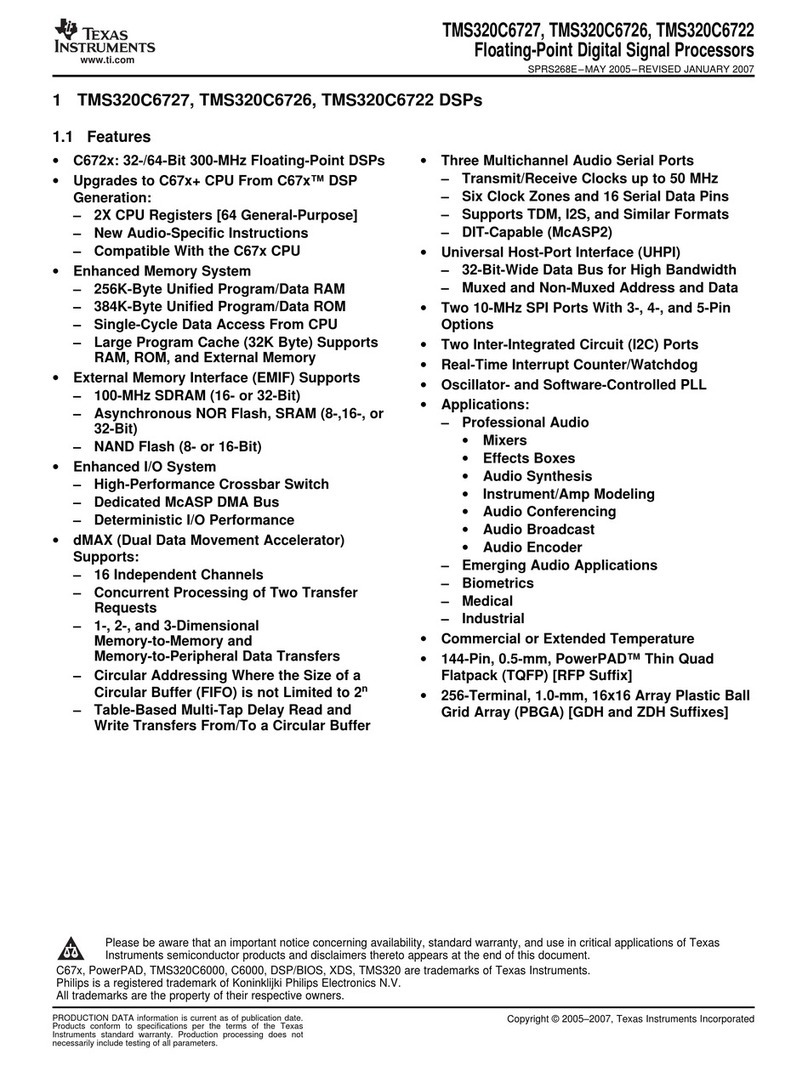
Texas Instruments
Texas Instruments TMS320C6722 user manual
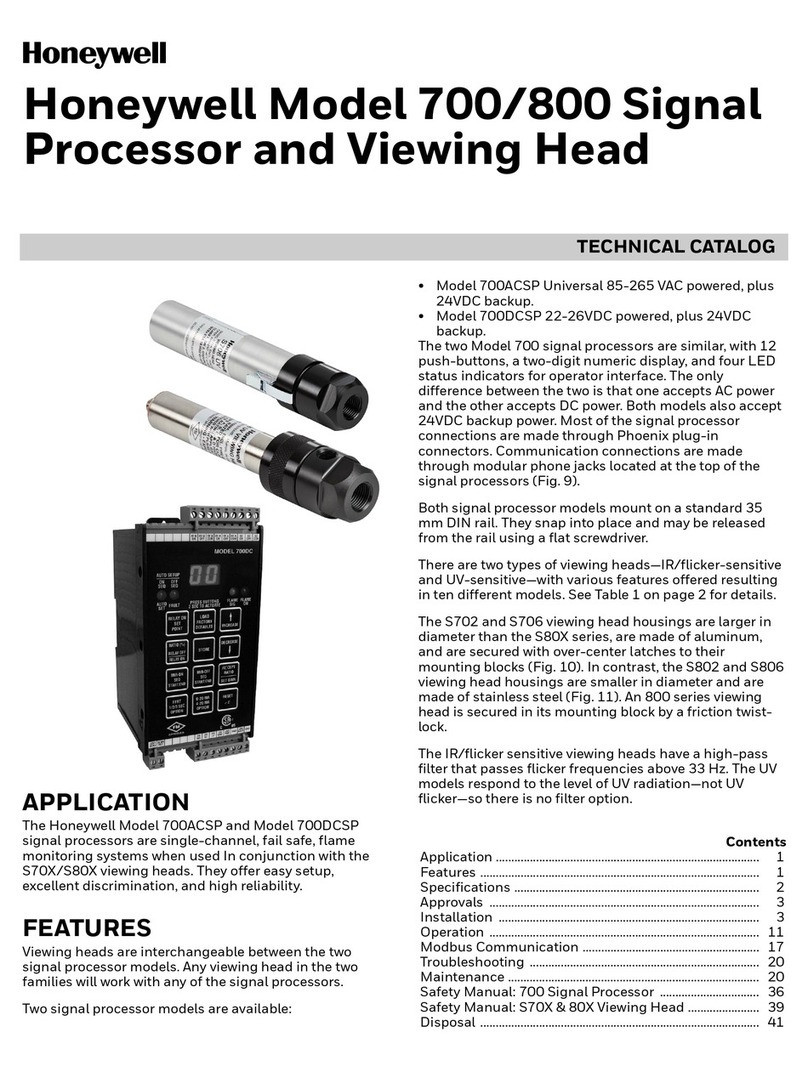
Honeywell
Honeywell 800 Series manual
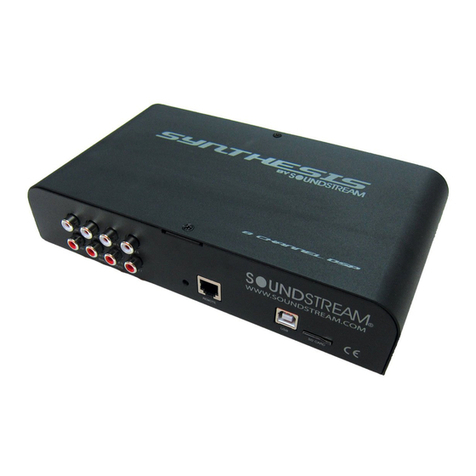
Soundstream
Soundstream SYNTHESIS user manual
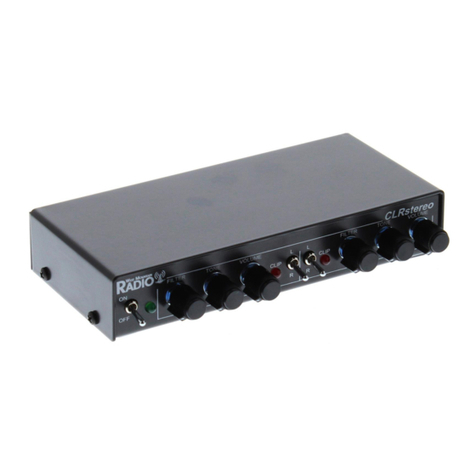
West Mountain Radio
West Mountain Radio CLRstereo ClearSpeech operating manual
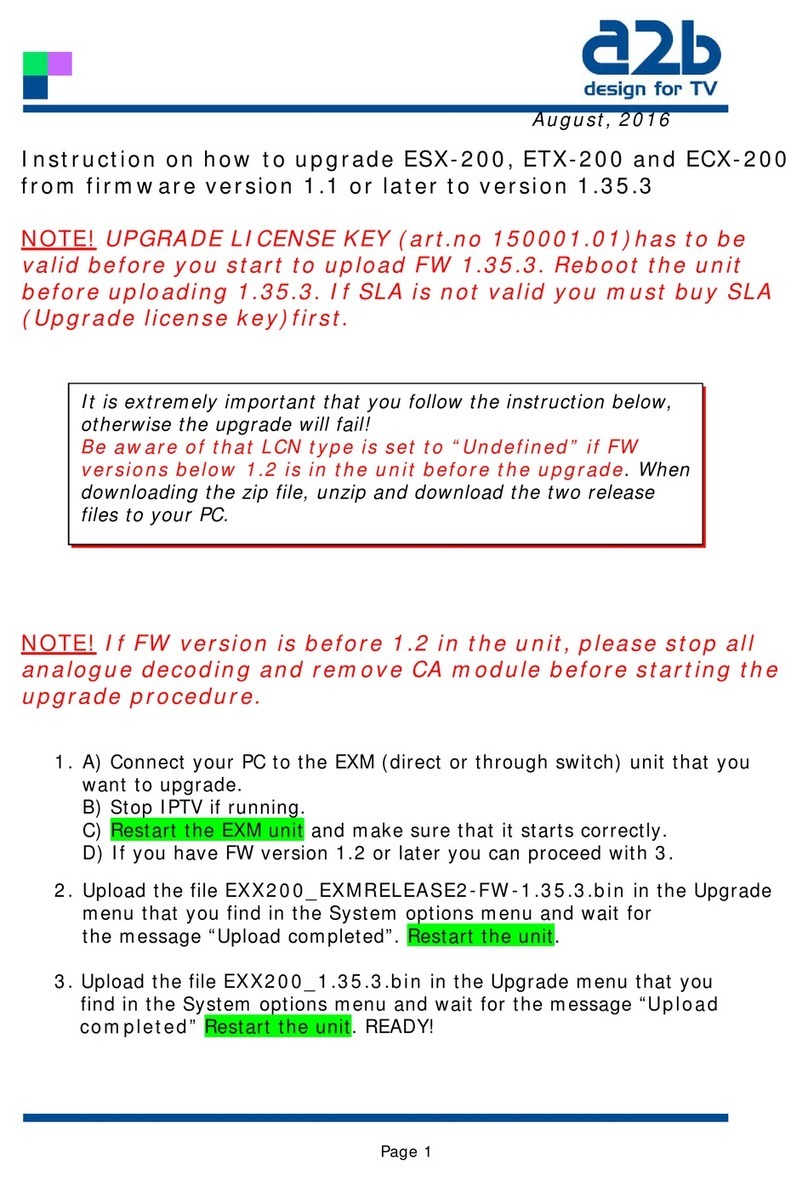
Wisi
Wisi a2b ESX-200 Upgrade instructions

Shinkawa
Shinkawa VM-21 Series instruction manual

